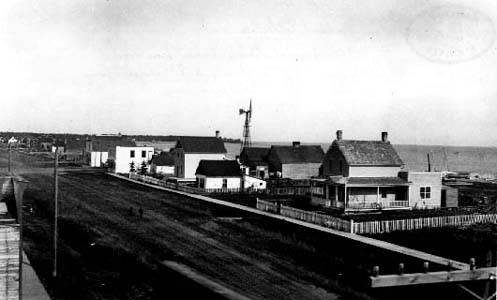Search | Image Archive | Reference | Communities | POV | Lesson Plans | Credits
 The first permanent Icelandic settlement in Manitoba was established at Willow Point in the fall of 1875. It was called Gimli, after the home of the Norse gods. It began as a cluster of multi- family shanties, a temporary settlement that would suffice until homesteads were established. The first winter was very hard, and the colonists wound up being dependent on the residents of nearby Sandy River for food. About half the settlers abandoned the community in the spring for Winnipeg and work on farms, while the remainder set to establishing an agricultural settlement.
The first permanent Icelandic settlement in Manitoba was established at Willow Point in the fall of 1875. It was called Gimli, after the home of the Norse gods. It began as a cluster of multi- family shanties, a temporary settlement that would suffice until homesteads were established. The first winter was very hard, and the colonists wound up being dependent on the residents of nearby Sandy River for food. About half the settlers abandoned the community in the spring for Winnipeg and work on farms, while the remainder set to establishing an agricultural settlement.
Most of those that arrived in 1875 had come to Canada between 1870 and 1874 to escape the destitution that plagued their homeland. They were a part of a larger emigration movement which saw large numbers of Icelanders flee the Danish tariffs, volcanic eruptions, and an epidemic that killed a large number of the Island's sheep and left the economy in ruins.
The agricultural development of New Iceland was slow, complicated by the poorly-drained, rocky soils of the area, but most families had established a working farm within the first year and moved from the sheds at Gimli to shanties on their own land.
The colony suffered great hardship in 1877, when a smallpox epidemic infected nearly a third of the population, killing nearly one hundred. The Icelanders fared better then their neighbours at Sandy River, who, being aboriginal and having little resistance to the European disease, were practically wiped-out. In 1879, the community suffered another setback when three quarters of the original families left the colony for Minnesota, the result of religious schism and frustration with the poor soils of the region.
After 1880, the settlement became more stable and started to grow again. The Icelanders put a great deal of emphasis on education, and a school was established for the colony at the Gimli site. Gimli also became home to a variety of small businesses, including a small dairy and several shops. Needed employment and income were supplied by Lake Winnipeg shipping, beginning with the first steamboat in 1897. In 1905, the railway came to town, making the developing fishery more profitable by reducing the cost of shipping fish to the United States. The coming of the railway also provided ready access to Gimli to the residents of Winnipeg, and Gimli became home to a number of modest summer cottages, and summer recreation provided another stimulus to the economy.
TimeLinks Characters: Bjorn Gudmundson grew up in Gimli and teaches at the school in Vidir
Page revised: 29 August 2009